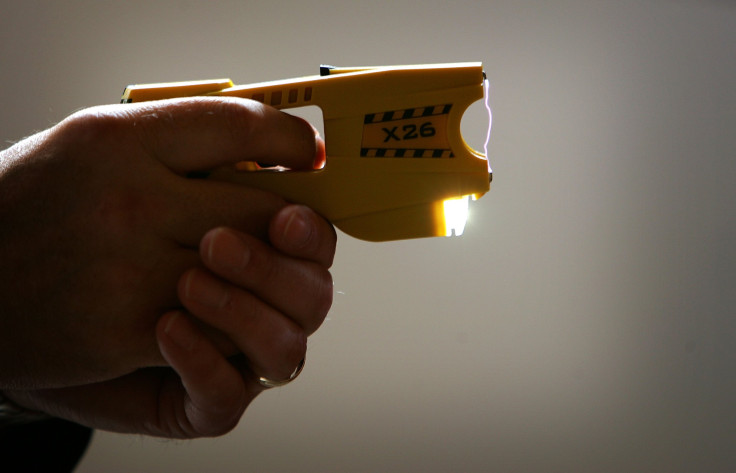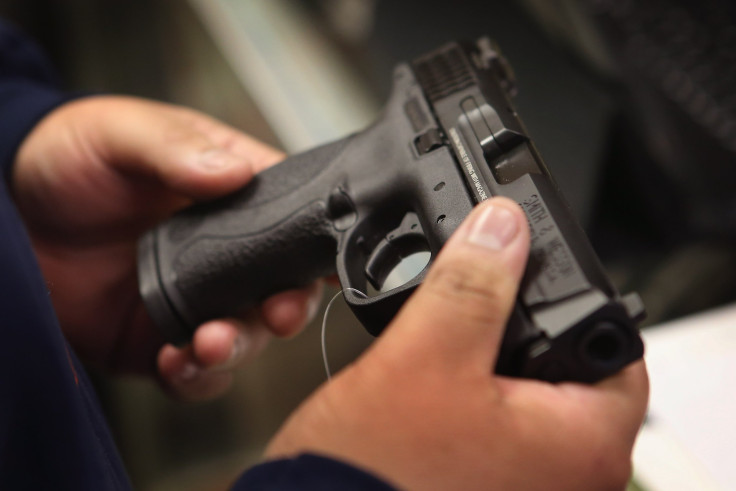Thanks To The Gun Lobby, In Some States It’s Easier To Carry A Handgun Than A Taser

On the afternoon of Sept. 29, 2011, the store manager of a local supermarket in Ashland, Massachusetts, called the police about a potential shoplifter. When the officers arrived, they confronted the accused suspect, a homeless woman named Jamie Caetano, who was sitting in the front seat of her car.
The officers asked to search Caetano’s purse. Caetano consented. They did not find any stolen items, but they did find an electronic stun gun. Caetano, who stands 4-foot-11, later testified she used the stun gun as protection against an abusive ex-boyfriend. It didn’t matter. Caetano was arrested, charged and later convicted for possession of a stun gun in violation of a Massachusetts state law that bans electric weapons.
Massachusetts has some of the toughest gun laws in the nation, but while Caetano or anyone else who passes a background check could legally carry a concealed gun, Tasers are banned.
Massachusetts is not alone in its ban on stun guns. Right now, five states — Massachusetts, New Jersey, New York, Rhode Island and Hawaii — and the District of Columbia have bans on the ownership of stun guns for those not in law enforcement. Even some gun-friendly cities, like New Orleans, make it illegal to own a stun guns or a Taser, which is the largest manufacturer of the device.
However, those laws may be superseded by the nation’s highest court this summer. After losing an appeal in Massachusetts’ high court last year, Caetano’s lawyer has presented the case for consideration at the Supreme Court. The court reviewed the case Friday and will decide in the coming days whether it will hear arguments.
To some attorneys, Caetano’s case illustrates something uniquely, almost extraordinarily American: In some states, you can walk into a store and buy a handgun or assault rifle without so much as a background check. But a Taser? Totally illegal. This is true, for instance, in New Orleans, where Tasers are prohibited but buyers can purchase as many handguns as they like.
How did this happen? Attorneys say while gun manufacturers enjoy strong support from the National Rifle Association (NRA) and other lobbyist groups, stun guns and other less lethal devices don’t enjoy the same sort of cohesive industry backing.
“You try to regulate guns, and the NRA gets upset,” says Eugene Volokh, a law professor at the University of California, Los Angeles. “Whereas, you try to regulate [stun guns], there’s nobody to speak up for them. ... Nobody has fond memories of going out and stun-gunning deer with their grandfather in the woods.”

Professor James Jacobs, a legal scholar at New York University who has researched gun legislation for more than three decades, agrees.
“The obvious answer to me, or at least the one that comes to mind, is that there’s such a strong lobby for guns and for firearms. It’s so mobilized that any proposed regulation is vetted and litigated and argued against, whereas you don’t have that kind of lobby when it comes to some legislature putting in a bill to regulate the less-fatal, less-deadly weapons. There’s no lobby there,” he said.
The NRA, for instance, spent $28 million in campaign and lobbying spending in 2014, data from the Center for Responsive Politics shows. Meanwhile, Taser spent $3.4 million in 2014 on consulting and lobbying, its most recent annual report showed.
However, that lobbying money is principally directed toward law enforcement purchases, not necessarily consumer purchases. That’s because Taser is more interested in arming police with Tasers than arming ordinary citizens. “Our primary target market for both our weapon and video products is federal, state and local law enforcement agencies in the U.S. and throughout the world,” the company notes in its annual report.
In 2014, private citizen purchases of Tasers accounted for just $3.7 million, compared to $43.5 million worth of Tasers sold to law enforcement, military and corrections professionals, company financials show. Steve Tuttle, a representative for the company, confirmed in an interview that "our bread and butter is police" and the company does not have any particular plans to lobby the states and local jurisdictions that ban Tasers. Still, he added, “it doesn't make any sense at all that those states don't allow it.”
Not suprisingly, political lobbying money is of little concern to Jamie Caetano, who testified in court her ex-boyfriend beat her so badly, she “ended up in the hospital.” Court documents show she purchased the stun gun for protection, and when her ex-boyfriend threatened her one day, she brandished the device, and the man “got scared and left [Caetano] alone.”
Stun guns vary in voltage and size, but there is little national data on fatalities resulting from consumer use of stun guns. Gun-related deaths, however, are tracked by the federal government, which reported 33,000 gun-related fatalities in 2013.
Being shocked by a stun gun is certainly a painful experience. “Imagine someone scratching your spine with a fork while an elephant sits on you,” wrote one commenter online. But to lawyers who support Caetano’s case, comparing guns to stun guns is like comparing apples to oranges. Clearly, they say, if guns are allowed for self-protection, stun guns should be too.
In 2014, Caetano’s attorneys appealed the lower court’s conviction to the Massachusetts Supreme Judicial Court. That court denied the woman’s appeal, concluding stun guns are not protected by the Second Amendment. In their opinion, the judges noted the 2008 landmark Supreme Court case, District of Columbia v. Heller, which upheld an individual’s right to possess a firearm for lawful purposes, but prohibited any weapons that would be considered “dangerous and unusual.”
Caetano attorney Benjamin Keehn now wants the court to review the case to challenge the notion stun guns should be considered “dangerous and unusual.”
“The petition should be granted so that the court can clarify whether the ‘dangerous and unusual’ limitation permits criminalizing the possession of weapons less lethal than firearms,” Keehn wrote in a motion filed earlier this year. (Keehn declined to comment on the current court proceedings.)
Lawyers for the state, however, wrote in a brief recently any “weapon designed to kill, injure or incapacitate with electricity is not the sort of weapon that was in common use at the time the Second Amendment was ratified. ... Nor does such a weapon have any conceivable ‘relationship to the preservation or efficiency of a well regulated militia.’ ” In other words, the lawyers argue stun guns are simply not the type of weapon the Second Amendment should protect.
Eugene Volokh, the law professor at UCLA, disagrees, and has written court filings in support of Keehn and Caetano. While Volokh agrees the Second Amendment should not be so broad as to cover “surface to air missiles,” he says less lethal weapons for self-defense should be protected by the Second Amendment.
“Lots of people want to have a nonlethal, or almost entirely nonlethal weapon at their disposal,” he says. “They want to be able to defend themselves, but they might be morally opposed to the use of deadly force even in self-defense, or they might not be allowed by law to have a weapon for self-defense.”
He added, “I think those are worthy desires that the law ought to protect, and that I think the Second Amendment does protect it.”
© Copyright IBTimes 2024. All rights reserved.






















